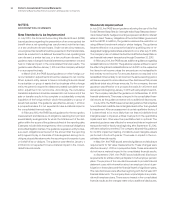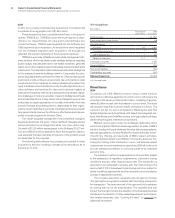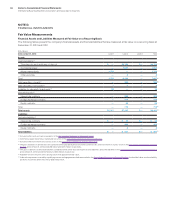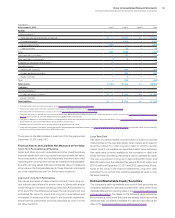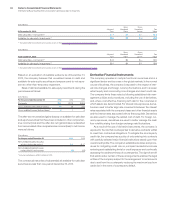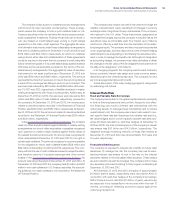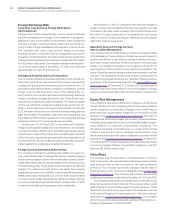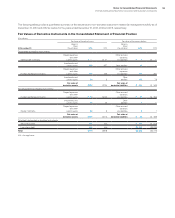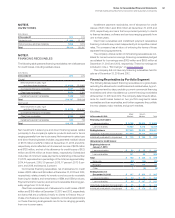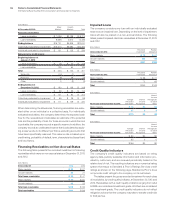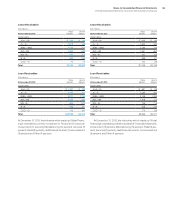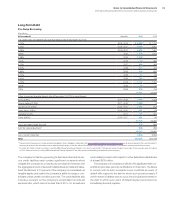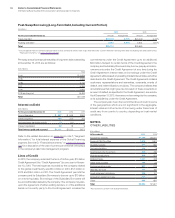IBM 2013 Annual Report Download - page 105
Download and view the complete annual report
Please find page 105 of the 2013 IBM annual report below. You can navigate through the pages in the report by either clicking on the pages listed below, or by using the keyword search tool below to find specific information within the annual report.
Notes to Consolidated Financial Statements
International Business Machines Corporation and Subsidiary Companies
104
Foreign Exchange Risk
Long-Term Investments in Foreign Subsidiaries
(Net Investment)
A large portion of the company’s foreign currency denominated debt
portfolio is designated as a hedge of net investment in foreign sub-
sidiaries to reduce the volatility in stockholders’ equity caused by
changes in foreign currency exchange rates in the functional cur-
rency of major foreign subsidiaries with respect to the U.S. dollar.
The company also uses cross-currency swaps and foreign
exchange forward contracts for this risk management purpose. At
December 31, 2013 and 2012, the total notional amount of derivative
instruments designated as net investment hedges was $3.0 billion
and $3.3 billion, respectively. The weighted-average remaining matu-
rity of these instruments at December 31, 2013 and 2012 was
approximately 0.4 years for both periods.
Anticipated Royalties and Cost Transactions
The company’s operations generate significant nonfunctional cur-
rency, third-party vendor payments and intercompany payments for
royalties and goods and services among the company’s non-U.S.
subsidiaries and with the parent company. In anticipation of these
foreign currency cash flows and in view of the volatility of the cur-
rency markets, the company selectively employs foreign exchange
forward contracts to manage its currency risk. These forward con-
tracts are accounted for as cash flow hedges. The maximum length
of time over which the company is hedging its exposure to the vari-
ability in future cash flows is four years. At December 31, 2013 and
2012, the total notional amount of forward contracts designated as
cash flow hedges of forecasted royalty and cost transactions was
$10.2 billion and $10.7 billion, respectively, with a weighted-average
remaining maturity of 0.7 years at both year-end dates.
At December 31, 2013 and 2012, in connection with cash flow
hedges of anticipated royalties and cost transactions, the company
recorded net losses of $252 million and $138 million (before taxes),
respectively, in AOCI. Within these amounts $166 million and $79
million of losses, respectively, are expected to be reclassified to net
income within the next 12 months, providing an offsetting economic
impact against the underlying anticipated transactions.
Foreign Currency Denominated Borrowings
The company is exposed to exchange rate volatility on foreign cur-
rency denominated debt. To manage this risk, the company employs
cross-currency swaps to convert fixed-rate foreign currency denom-
inated debt to fixed-rate debt denominated in the functional currency
of the borrowing entity. These swaps are accounted for as cash flow
hedges. The maximum length of time over which the company
hedges its exposure to the variability in future cash flows is approxi-
mately seven years. At December 31, 2013 the total notional amount
of cross currency swaps designated as cash flow hedges of foreign
currency denominated debt was $1.2 billion. At December 31, 2012,
no instruments relating to this program were outstanding.
At December 31, 2013, in connection with cash flow hedges of
foreign currency denominated borrowings, the company recorded
net losses of $9 million (before taxes) in AOCI. Within this amount,
$3 million of losses is expected to be reclassified to net income
within the next 12 months, providing an offsetting economic impact
against the underlying exposure.
Subsidiary Cash and Foreign Currency
Asset/Liability Management
The company uses its Global Treasury Centers to manage the cash
of its subsidiaries. These centers principally use currency swaps to
convert cash flows in a cost-effective manner. In addition, the com-
pany uses foreign exchange forward contracts to economically
hedge, on a net basis, the foreign currency exposure of a portion of
the company’s nonfunctional currency assets and liabilities. The
terms of these forward and swap contracts are generally less than
one year. The changes in the fair values of these contracts and of
the underlying hedged exposures are generally offsetting and are
recorded in other (income) and expense in the Consolidated State-
ment of Earnings. At December 31, 2013 and 2012, the total notional
amount of derivative instruments in economic hedges of foreign
currency exposure was $14.7 billion and $12.9 billion, respectively.
Equity Risk Management
The company is exposed to market price changes in certain broad
market indices and in the company’s own stock primarily related to
certain obligations to employees. Changes in the overall value of
these employee compensation obligations are recorded in SG&A
expense in the Consolidated Statement of Earnings. Although not
designated as accounting hedges, the company utilizes derivatives,
including equity swaps and futures, to economically hedge the expo-
sures related to its employee compensation obligations. The
derivatives are linked to the total return on certain broad market
indices or the total return on the company’s common stock. They
are recorded at fair value with gains or losses also reported in SG&A
expense in the Consolidated Statement of Earnings. At December
31, 2013 and 2012, the total notional amount of derivative instruments
in economic hedges of these compensation obligations was $1.3
billion and $1.2 billion, respectively.
Other Risks
The company may hold warrants to purchase shares of common
stock in connection with various investments that are deemed deriva-
tives because they contain net share or net cash settlement
provisions. The company records the changes in the fair value of
these warrants in other (income) and expense in the Consolidated
Statement of Earnings. The company did not have any warrants
qualifying as derivatives outstanding at December 31, 2013 and 2012.
The company is exposed to a potential loss if a client fails to pay
amounts due under contractual terms. The company utilizes credit
default swaps to economically hedge its credit exposures. These
derivatives have terms of one year or less. The swaps are recorded
at fair value with gains and losses reported in other (income) and
expense in the Consolidated Statement of Earnings. The company
did not have any derivative instruments relating to this program out-
standing at December 31, 2013 and 2012.


